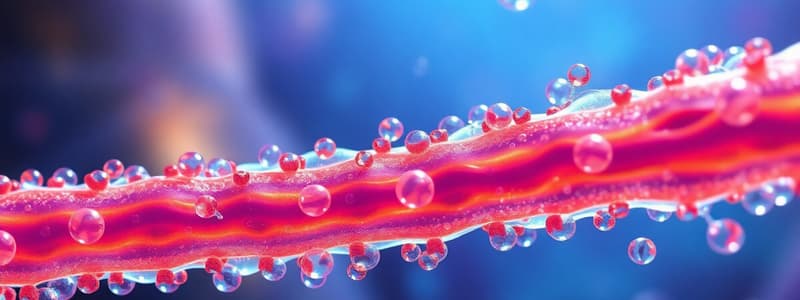Podcast
Questions and Answers
What is a primary function of the cell membrane?
What is a primary function of the cell membrane?
- Facilitates photosynthesis
- Stores genetic information
- Regulates what enters and exits the cell (correct)
- Provides structure and support to the cell
Which component is specifically found in the cell wall of plant cells?
Which component is specifically found in the cell wall of plant cells?
- Peptidoglycan
- Cellulose (correct)
- Phospholipids
- Chitin
What describes the characteristic nature of phospholipids in the cell membrane?
What describes the characteristic nature of phospholipids in the cell membrane?
- Both ends are hydrophobic
- One end is hydrophobic, and the other is hydrophilic (correct)
- Both ends are hydrophilic
- They dissolve completely in water
Which of the following is NOT a function of the cell membrane?
Which of the following is NOT a function of the cell membrane?
What characteristic is used to describe the structure of the cell membrane?
What characteristic is used to describe the structure of the cell membrane?
What role do glycoproteins play on the surface of red blood cells?
What role do glycoproteins play on the surface of red blood cells?
What characteristic distinguishes the fluid mosaic model of the cell membrane?
What characteristic distinguishes the fluid mosaic model of the cell membrane?
Which function is NOT associated with receptor proteins?
Which function is NOT associated with receptor proteins?
What does the term 'mosaic' refer to in the fluid mosaic model?
What does the term 'mosaic' refer to in the fluid mosaic model?
How do peripheral proteins contribute to the function of the cell membrane?
How do peripheral proteins contribute to the function of the cell membrane?
Flashcards
Cell Membrane
Cell Membrane
A flexible barrier that surrounds all cells, regulating what enters and exits, and enabling communication between cells.
Cell Wall
Cell Wall
A rigid outer layer found in plant cells, fungal cells, and bacteria cells, providing structure and support.
Cytoplasm
Cytoplasm
The fluid inside a cell that contains all the cellular components.
Phospholipid
Phospholipid
Signup and view all the flashcards
Phospholipid Bilayer
Phospholipid Bilayer
Signup and view all the flashcards
What are glycoproteins and their role in blood types?
What are glycoproteins and their role in blood types?
Signup and view all the flashcards
What do receptor proteins do?
What do receptor proteins do?
Signup and view all the flashcards
What are peripheral proteins?
What are peripheral proteins?
Signup and view all the flashcards
Explain the fluid mosaic model of the cell membrane.
Explain the fluid mosaic model of the cell membrane.
Signup and view all the flashcards
How do membrane proteins influence cell function?
How do membrane proteins influence cell function?
Signup and view all the flashcards
Study Notes
Cell Boundaries
- Cell membranes are found in all cells and are flexible.
- They regulate what enters and exits the cell and facilitate cell communication.
- Cell membranes are composed of phospholipids, cholesterol, and proteins.
Cell Wall
- Cell walls are found in plant cells, fungal cells, and bacteria (and some protists).
- They are rigid and provide structure and support.
- Cell walls are composed of strong chains of polysaccharides.
- Plants have cellulose
- Fungi have chitin
- Bacteria have peptidoglycan
Functions of Cell Membrane
- Acts as a barrier between the cell's interior (cytoplasm) and the external environment.
- Is semipermeable, allowing some substances to pass through while blocking others.
- Plays a role in cell identification.
- Facilitates cell communication by receiving and sending signals.
Phospholipids
- Phospholipids have a hydrophilic (water-attracting) head and hydrophobic (water-repelling) tails.
- This structure allows them to arrange themselves in a bilayer.
Plasma/Cell Membrane Structure
- The cell membrane includes phospholipids, cholesterol, proteins (integral and peripheral), and glycoproteins/glycolipids.
- Phospholipids form the basic structure of the cell membrane.
- Proteins are embedded within or attached to the phospholipid bilayer.
- Cholesterol maintains membrane fluidity and firmness.
- Glycoproteins and glycolipids play a role in cell recognition.
Cholesterol
- Cholesterol helps maintain membrane structure and fluid properties. It is located within the hydrophobic interior of the membrane bilayer.
Glycoproteins (Cell ID Tags)
- Glycoproteins are cell surface markers involved in cell recognition.
- Blood type is determined by distinct glycoproteins.
Receptor Proteins
- Receptor proteins receive and transmit signals across the cell membrane.
- These proteins can bind to signalling molecules.
Peripheral Proteins
- Peripheral proteins are attached to the cell membrane but not embedded in it.
- Some function in intracellular signaling or connecting to the cytoskeleton.
Cytoskeleton and Peripheral Proteins (Important for anchoring)
- Peripheral proteins are anchored to the cell's cytoskeleton.
- This connection provides structural support and facilitates intracellular signal transmission.
Fluid Mosaic Model
- The cell membrane is described as fluid because its components can move laterally.
- It's a mosaic of different molecules, giving it a patterned appearance when viewed from above.
Many Functions of Membrane Proteins
- Proteins embedded in the membrane carry out various functions, including transport, signaling, and cell adhesion.
- Transporters: facilitate movement of substances across the membrane.
- Cell surface receptors: receive signals from the environment.
- Cell adhesion proteins: link cells to each other or to the extracellular matrix.
- Anchors: provide structural stability and intracellular signaling.
Passive Transport
- Passive transport occurs when molecules move from high to low concentration across the membrane without energy.
- This is often done through channels in the membrane.
Active Transport
- Active transport requires energy to move molecules against their concentration gradient.
- This often utilizes protein pumps in the membrane.
Studying That Suits You
Use AI to generate personalized quizzes and flashcards to suit your learning preferences.




